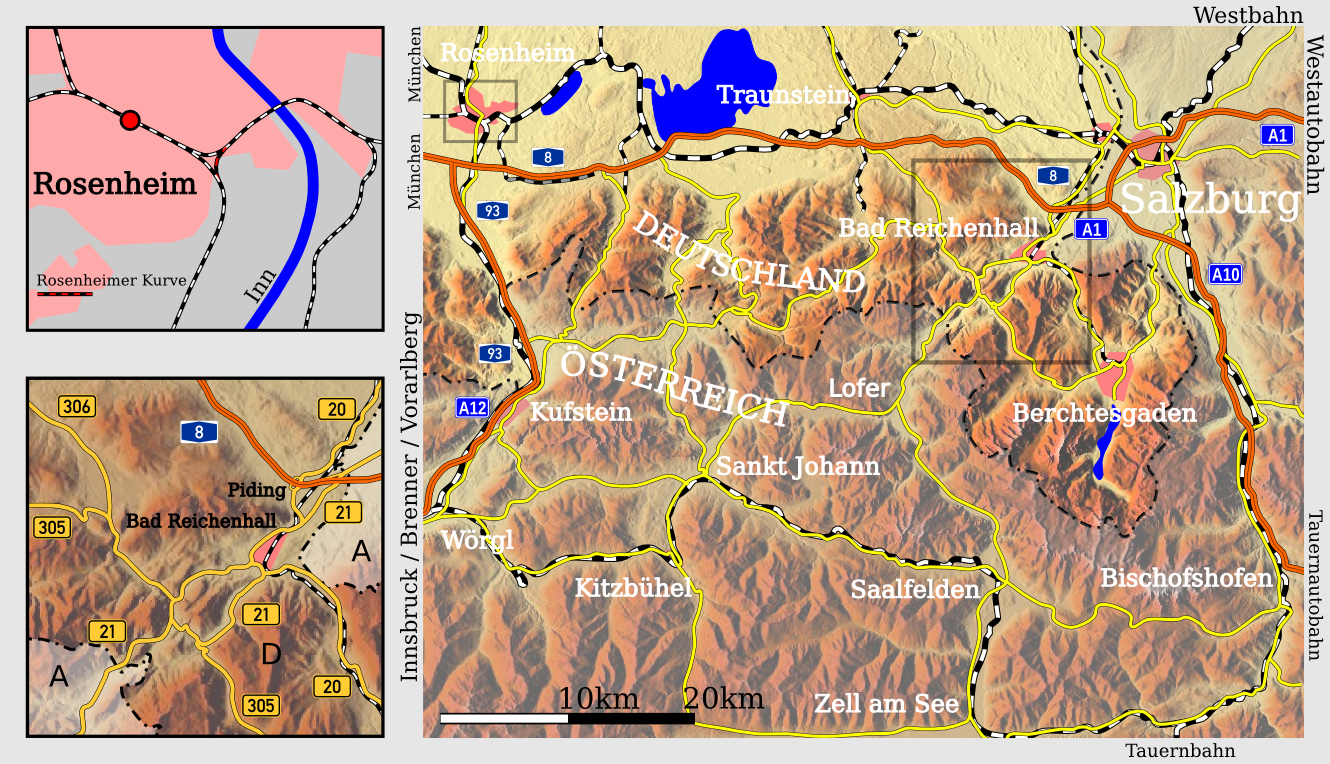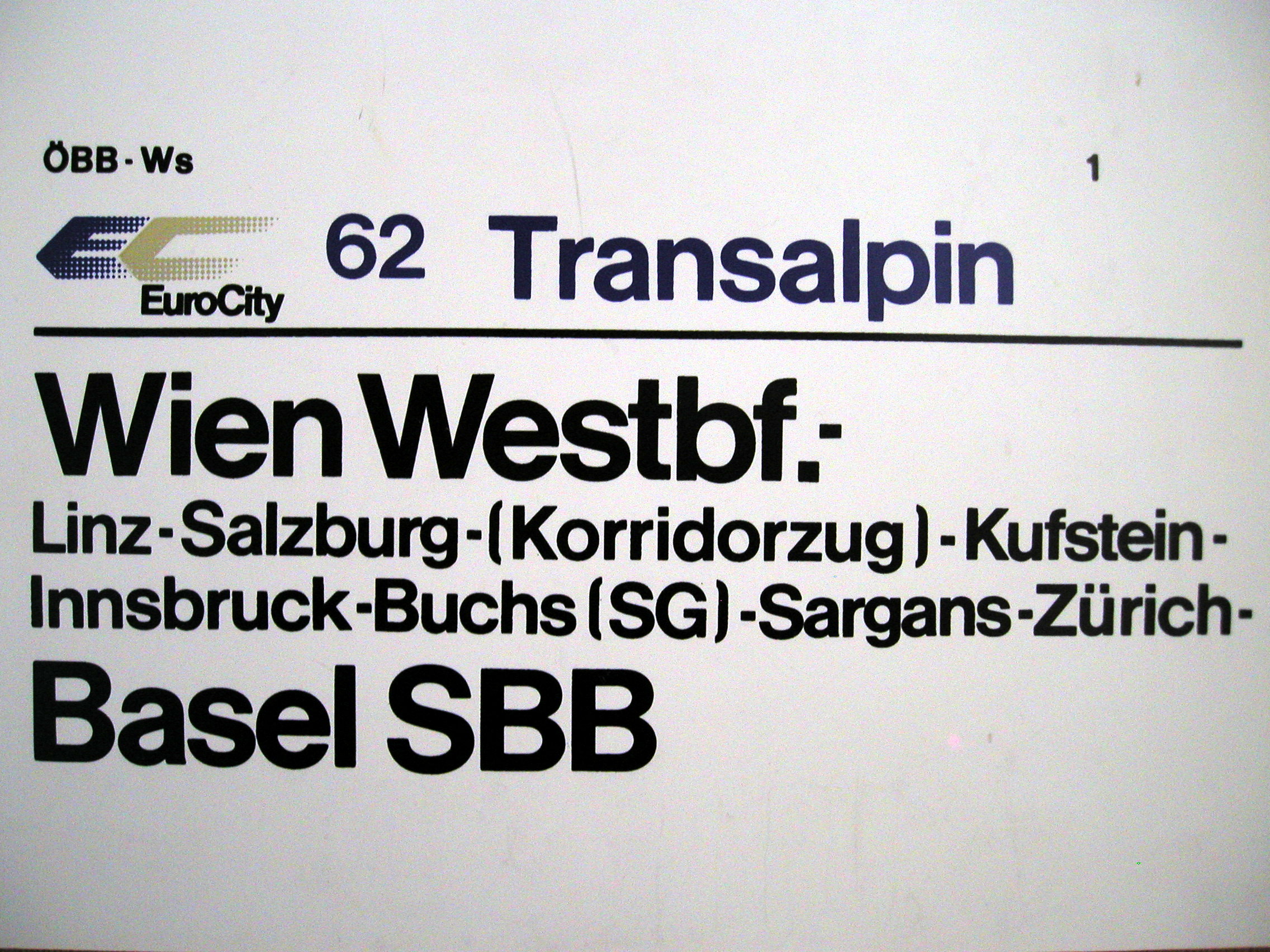|
Rosenheim Station
Rosenheim station (german: Bahnhof Rosenheim) is the main railway station in the city of Rosenheim in Bavaria, Germany. It is the seventh largest passenger station in Bavaria and an important railway hub between the Munich–Rosenheim railway line and the lines to Salzburg, Kufstein/Innsbruck and Mühldorf, as well as the Mangfall Valley Railway. Rosenheim is operated by DB Station&Service, a subsidiary of Deutsche Bahn AG, and is classified as a Category 2 station History A first station on the Rosenheim–Kufstein–Innsbruck line, promoted by industrialist Joseph Maffei and King Maximilian II of Bavaria, was opened on 31 October 1857. Located south of the city centre, it soon proved to be too small after the opening of the line to Salzburg in 1860 and the Austrian Brenner Railway in 1867. From 1873 onwards, a new station at the present site was built; it was inaugurated on 19 April 1876. After only 18 years of usage, the old station building was sold to the City of Rosenh ... [...More Info...] [...Related Items...] OR: [Wikipedia] [Google] [Baidu] |
Rosenheim
Rosenheim is a city in Bavaria, Germany. It is an independent city located in the centre of the district of Rosenheim (Upper Bavaria), and is also the seat of its administration. It is located on the west bank of the Inn at the confluence of the rivers Inn and Mangfall, in the Bavarian Alpine Foreland. It is the third largest city in Upper Bavaria with over 63,000 inhabitants. Rosenheim is the economic centre and the busiest place in the region. Geography The population of the actual city is approximately 60,000 inhabitants with up to 125,000 in the surrounding area. Rosenheim is situated in the Upper-Bavarian Alpine Foothills, above sea level and covers an area of . The capital of Bavaria, Munich, is North-West of Rosenheim. Rosenheim station is at the junction of the Munich–Rosenheim, the Rosenheim–Salzburg and the Munich–Innsbruck lines. The landscape around Rosenheim was formed during the last ice age from the advancement of the Inn Valley Glacier and later the Ro ... [...More Info...] [...Related Items...] OR: [Wikipedia] [Google] [Baidu] |
Upper Bavaria
Upper Bavaria (german: Oberbayern, ; ) is one of the seven administrative districts of Bavaria, Germany. Geography Upper Bavaria is located in the southern portion of Bavaria, and is centered on the city of Munich, both state capital and seat of the district government. Because of this, it is by far the most populous administrative division in Bavaria. It is subdivided into four planning regions (''Planungsverband''): Ingolstadt, Munich, Bayerisches Oberland (Bavarian Highland), and Südostoberbayern (South East Upper Bavaria). The name 'Upper Bavaria' refers to the relative position on the Danube and its tributaries: downstream, Upper Bavaria is followed by Lower Bavaria, then Upper Austria, and subsequently Lower Austria. ''Landkreise'' (districts): * Altötting * Bad Tölz-Wolfratshausen * Berchtesgadener Land * Dachau * Ebersberg * Eichstätt * Erding * Freising * Fürstenfeldbruck * Garmisch-Partenkirchen * Landsberg * Miesbach * Mühldorf * Munich (''München'') ... [...More Info...] [...Related Items...] OR: [Wikipedia] [Google] [Baidu] |
Regional-Express
In Germany, Luxembourg and Austria, the Regional-Express (RE, or in Austria: REX) is a type of regional train. It is similar to a semi-fast train, with average speed at about 70–90 km/h (top speed often 160 km/h) as it calls at fewer stations than '' Regionalbahn'' or S-Bahn trains, but stops more often than ''InterCity'' services. Operations The first Regional-Express services were operated by DB Regio, though since the liberalisation of the German rail market (''Bahnreform'') in the 1990s many operators have received franchise rights on lines from the federal states. Some private operators currently operate trains that are similar to a Regional-Express service, but have decided to use their own names for the sake of brand awareness instead. Regional-Express services are carried out with a variety of vehicles such as DMUs (of Class 612), EMUs (of Class 425 or 426) or, most commonly, electric or diesel locomotives with double-deck cars, the latter often with ... [...More Info...] [...Related Items...] OR: [Wikipedia] [Google] [Baidu] |
Austrian Federal Railways
Austrian may refer to: * Austrians, someone from Austria or of Austrian descent ** Someone who is considered an Austrian citizen, see Austrian nationality law * Austrian German dialect * Something associated with the country Austria, for example: ** Austria-Hungary ** Austrian Airlines (AUA) ** Austrian cuisine ** Austrian Empire ** Austrian monarchy ** Austrian German (language/dialects) ** Austrian literature ** Austrian nationality law ** Austrian Service Abroad ** Music of Austria ** Austrian School of Economics * Economists of the Austrian school of economic thought * The Austrian Attack variation of the Pirc Defence chess opening. See also * * * Austria (other) * Australian (other) Australian(s) may refer to: Australia * Australia, a country * Australians, citizens of the Commonwealth of Australia ** European Australians ** Anglo-Celtic Australians, Australians descended principally from British colonists ** Aboriginal Au ... * L'Autrichienne (d ... [...More Info...] [...Related Items...] OR: [Wikipedia] [Google] [Baidu] |
Deutsches Eck (transport Link)
The ''Deutsches Eck'' ("German Corner") is the name given to the shortest and most convenient road and railway link between the Austrian metropolitan region of Salzburg and the Tyrolean Unterland with the state capital Innsbruck. Due to the mountainous landscape and the irregular course of the border, the main transport routes to the western Austrian states of Tyrol and Vorarlberg pass through the territory of the German state of Bavaria. While an alternative, albeit longer, all-Austrian Salzburg-Tyrol Railway exists, there is no continuous, intra-Austrian motorway route between the states of Salzburg and Tyrol. Großes Deutsches Eck A larger railway and autobahn (motorway) link runs from Salzburg westwards along the northern rim of the Chiemgau Alps to the Bavarian town of Rosenheim, then turns south through the Inn valley to reach the Tyrolean border at Kufstein. Since the conclusion of an 1851 treaty between the Austrian Empire and the Kingdom of Bavaria, [...More Info...] [...Related Items...] OR: [Wikipedia] [Google] [Baidu] |
Privileged Transit Traffic
Privileged transit traffic or corridor traffic is traffic of one country across the territory of another country without usual customs and passport checks. The corresponding line of communication (usually a railway) is called the (privileged) traffic corridor and a train used in this kind of transit is called a corridor train (german: Korridorzug, it, Treno-corridoio). The reason for such arrangements is usually border changes or border creation which cut through an existing transport corridor. Examples Belgium *Vennbahn was a railway built 1885 at the time fully in Germany. In 1919 some areas were transferred to Belgium. The railway did as a result cross the new border several times. To handle this, the railway embankment with tracks were also made Belgian territory if inside Germany, without having border controls at the road-rail crossings. The railway was dismantled in 2008, although the embankment still belongs to Belgium. Estonia *The road from Värska to Ulitina in Estoni ... [...More Info...] [...Related Items...] OR: [Wikipedia] [Google] [Baidu] |
Strategic Bombing In World War II
World War II (1939–1945) involved sustained strategic bombing of railways, harbours, cities, workers' and civilian housing, and industrial districts in enemy territory. Strategic bombing as a military strategy is distinct both from close air support of ground forces and from tactical air power. During World War II, many military strategists of air power believed that air forces could win major victories by attacking industrial and political infrastructure, rather than purely military targets. Strategic bombing often involved bombing areas inhabited by civilians, and some campaigns were deliberately designed to target civilian populations in order to terrorize them and disrupt their usual activities. International law at the outset of World War II did not specifically forbid the aerial bombardment of cities – despite the prior occurrence of such bombing during World War I (1914–1918), the Spanish Civil War (1936–1939), and the Second Sino-Japanese War (1937–1945). ... [...More Info...] [...Related Items...] OR: [Wikipedia] [Google] [Baidu] |
Bahnbetriebswerk
A ''Bahnbetriebswerk'' is the equivalent of a locomotive depot (or motive power depot) on the German and Austrian railways. It is an installation that carries out the maintenance, minor repairs, refuelling and cleaning of locomotives and other motive power. In addition it organises the deployment of locomotives and crews. In the Deutsche Bahn, a ''Bahnbetriebswerk'' is known today as a ''Betriebshof''; the ÖBB refer to it as a ''Zugförderungsstelle'' (''Zf''). Many other countries simply use the term 'depot'. The smaller facility, the ''Lokomotivstation'' (also ''Einsatzstelle'' or ''Lokbahnhof'') akin to the British sub-depot or stabling point, is affiliated to a ''Bahnbetriebswerk''. N.B. The shortened form ''Betriebswerk'' is also used and both are commonly abbreviated to Bw or BW. The plural is ''Bahnbetriebswerke''. History Beginnings On 7 January 1835 the first ''Bahnbetriebswerk'' in Germany was opened. It looked after locomotives on the first railway line in Ge ... [...More Info...] [...Related Items...] OR: [Wikipedia] [Google] [Baidu] |
Locomotive Depot
The motive power depot (MPD) or locomotive depot, or traction maintenance depot (TMD), is the place where locomotives are usually housed, repaired and maintained when not being used. They were originally known as "running sheds", "engine sheds" or, for short, just sheds. Facilities are provided for refuelling and replenishing water, lubricating oil and grease and, for steam engines, disposal of the ash. There are often workshops for day to day repairs and maintenance, although locomotive building and major overhauls are usually carried out in the locomotive works. (Note: In American English, the term ''depot'' is used to refer to passenger stations or goods (freight) facilities and not to vehicle maintenance facilities.) German practice The equivalent of such depots in German-speaking countries is the ''Bahnbetriebswerk'' or ''Bw'' which has similar functions, with major repairs and overhauls being carried out at '' Ausbesserungswerke''. The number of these reduced drasti ... [...More Info...] [...Related Items...] OR: [Wikipedia] [Google] [Baidu] |


_(2).jpg)



